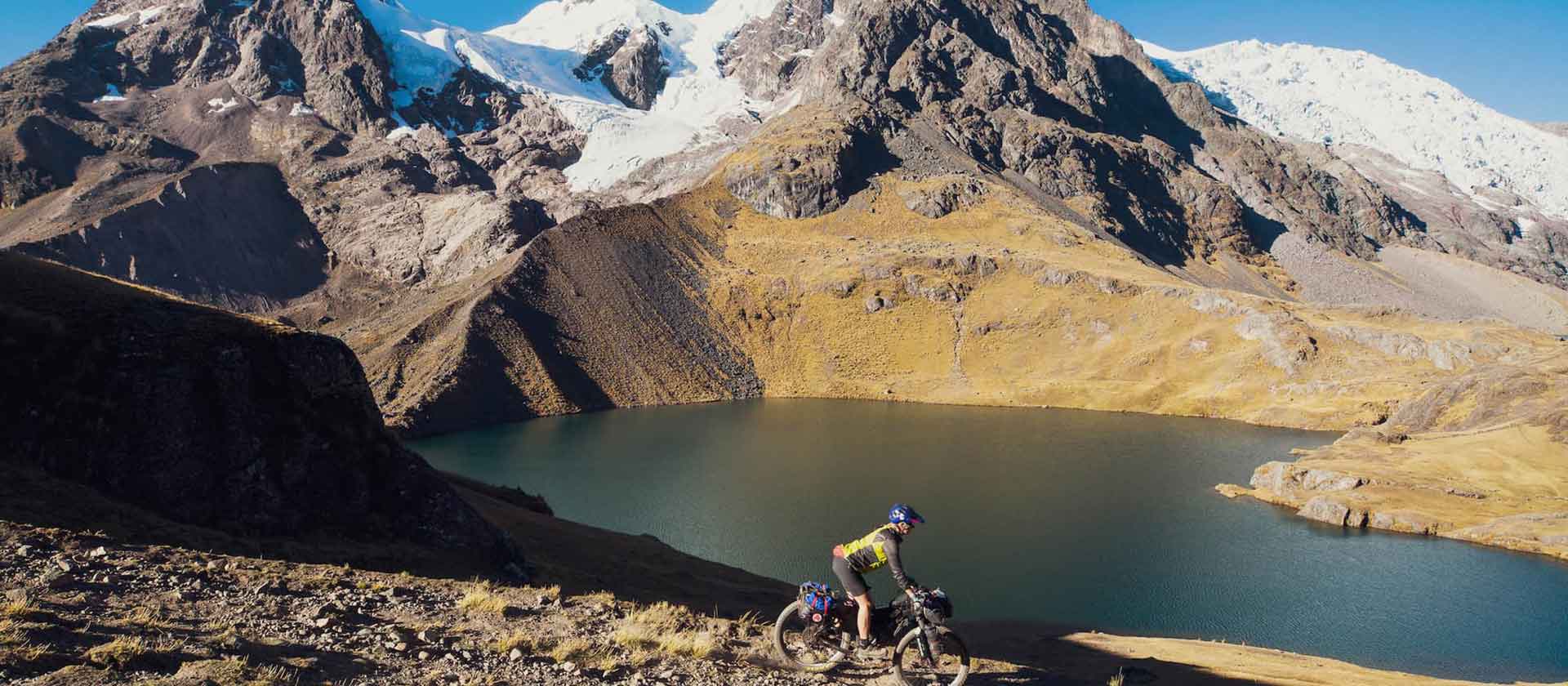
The broken granite that’s scattered over the path crunches under my feet as I push my bike up the steep path. My body is begging for more oxygen, and no matter how rampant my breathing, I just can’t can’t seem to match supply to demand. Slowing down doesn’t help much; my legs feel weak and pathetic and no measure of willpower seems to overcome my torpor.
I might not be as well acclimatised as I’d like, but I can’t really complain. At 15,000 feet the high altitude sun is hot on my back. The weather is bluebird, with just the most delicate wisps of white cloud drifting slowly over the tops of the peaks.
Eventually the terrain tips downhill. I throw a leg over my bike and shuffle onto the saddle. From corner to corner I flow, Brendan’s wheel is just ahead, kicking up clouds of dust as he flicks his bike through the switchbacks. The trail’s perfect: 100 percent rideable but with the unpredictability that makes hiking trails so much fun to ride. There’s no bermed corners here, just a rugged mountain trail that delivers satisfaction with every rocky corner, dropoff and dusty straight.
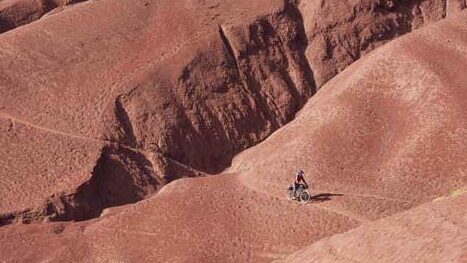
In a country famous for its challenging, high altitude alpine treks, the Ausangate Circuit stands as one of the best. The towering white massif of Ausangate mountain (20,945ft) can easily be seen from the ancient Inca capital of Cusco, shimmering temptingly on the horizon.
The region is home to indigenous Quechua alpaca and llama farmers – direct descendants of the Inca – and one of the last pastoralist societies in the world. These hardy weather-beaten people graze their animals and traverse the mountain terrain via a series of historic pathways that have been etched by time and animal hooves into the slopes of the mountain.
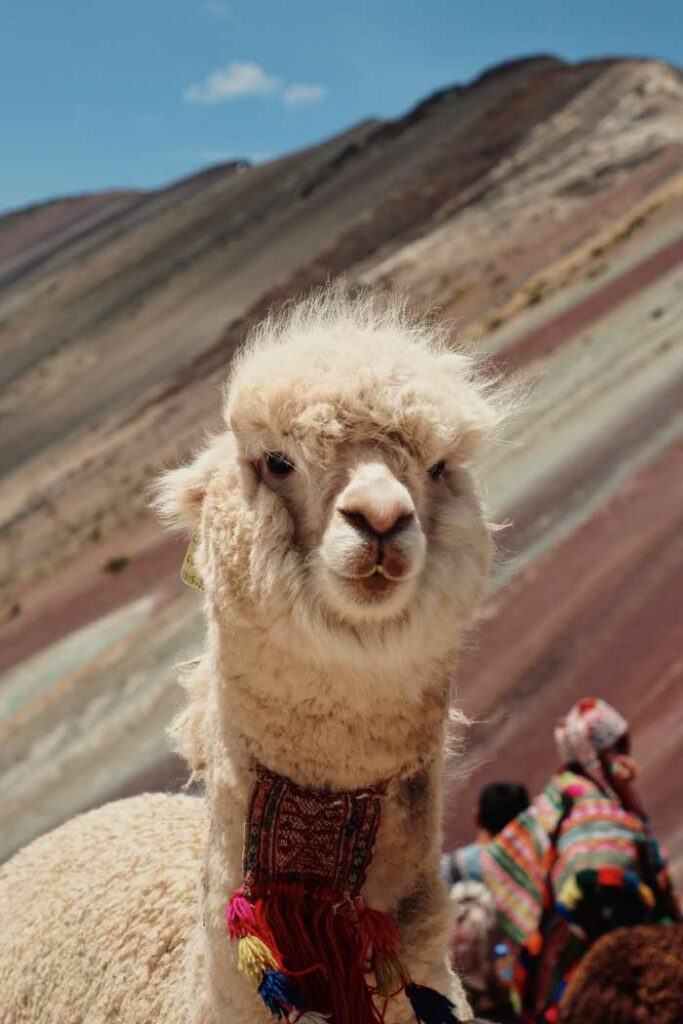
The paths weave their way from pass to pass, through tumbled moraine, turquoise lakes and over the golden pampa that rings the lower slopes of the mountain. It’s a route that lends itself not only to trekking, but also as a bikepacking route that is about as close to perfection as alpine singletrack can be.
We became aware of the Ausangate Circuit through our desire to incorporate the Ruta De Las Tres Cordilleras bikepacking route – which it is a part of – into our multi-year Alaska–Patagonia bikepacking ride. We’d also picked up a bit of advice through the bikepacking community that it was possible to link the route to Rainbow Mountain and the Valle Rojo, which is a stunning region of colourful, heavily stratified rocks and minerals.
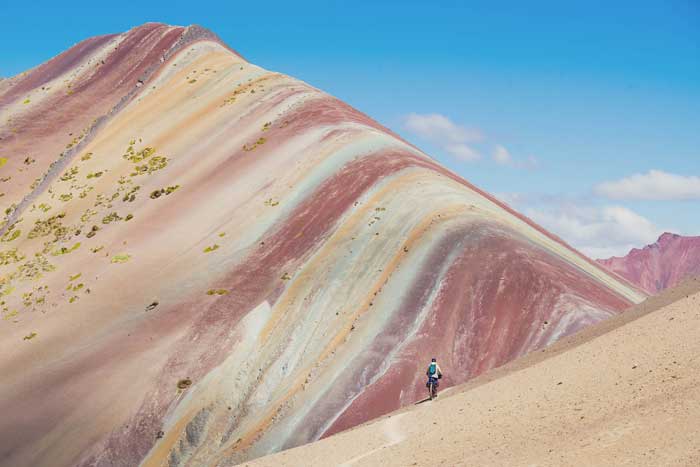
While our motivation was high, our level of preparation wasn’t, as we’d lost both fitness and acclimatisation with a sickness-enforced layoff from riding in past weeks. With an average elevation of around 14,000 feet and over 12,400 feet of climbing over its 88 mile length it had all the hallmarks of either a demanding ‘get fit trip’ or a pedal and push through hell. It turned out to be quite a lot of the latter.
We eased into the ride, taking an acclimatisation and rest day at the village of Chillca. The Quechua inhabitants were shy, but we broke the ice a little by buying some supplies from their small store. We’d taken three days to ride from Cusco to there, gradually gaining elevation. Downslope of the village’s rustic mud brick huts we set up camp beside a small stream. Come sunset the temperature soon dropped to 14 degrees f, a chilly welcome to the very cold nights of the dry season (winter) in the Andes, but the freezing nights are tempered by stable weather and windless sunny days, making for perfect riding conditions.
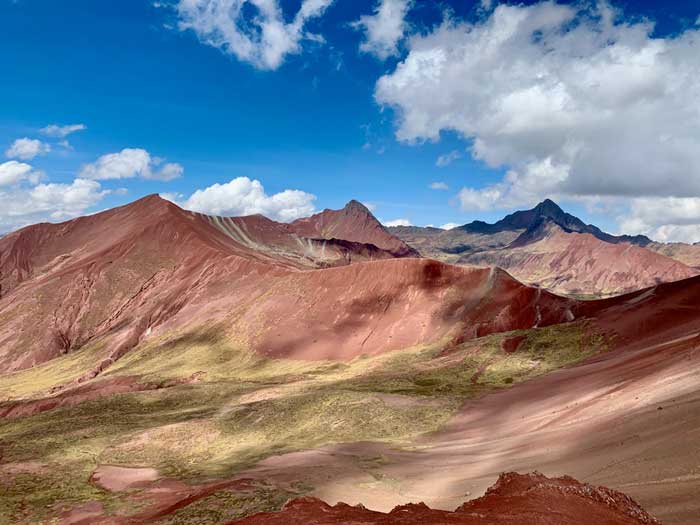
Our first challenge was a long day of farm tracks, singletrack and hike-a-bike to Campa Pass at 16,400ft. We made steady progress towards a wall of stunning glaciated peaks at the head of the valley, before making a steeper uphill grind and push to reach the pass. We felt pretty good; short of breath, but free of any of the more debilitating symptoms of altitude problems.
Needle-like granite peaks, streaked with narrow ice couloirs and capped with glaciers surrounded us as we crossed the pass. The reward for our labours was a perfect downhill of sinuous trail that threaded its way down towards a series of small lakes. Even in the chill of the afternoon shade it was a blissfully fun descent.
Darkness was falling as we set up camp beside one of the lakes. As we boiled water for dinner the insidious grip of an altitude headache began and with that my appetite waned, but we forced down some food, knowing we had several days of riding to go. After dark our friend Brendan – joining us from Cusco – arrived at camp, having put in a race-pace effort to reach our camp in the growing darkness.
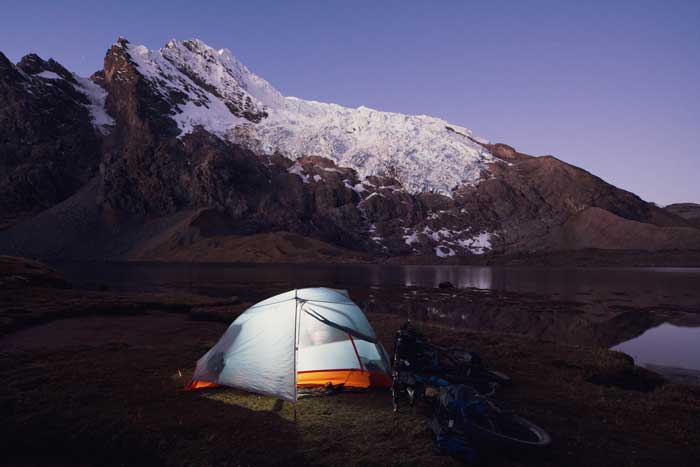
The following morning was a blur of singletrack, route finding across the open pampa and stunning mountain views as we circumnavigated more of the range. Both Hana and I were experiencing the classic symptoms of mild AMS (acute mountain sickness) by now, finding ourselves headachy, unable to eat much and generally lethargic, but our motivation was still high with so much good riding to look forward to.
After lunch we crossed the highest pass of the day, which became a determined effort of very slow hike-a-bike as the AMS killed any spring in our step and made uphill progress a slow trudge at best, with frequent stops to get some oxygen back in the bloodstream. Having already cycled many thousands of kilometres at altitude through Colombia, Ecuador and Peru we weren’t used to feeling so crippled by the rarefied air.
The trail dropped again and the three of us sped across scree slopes and through technical sections of trail as we descended into the next valley. The tone of the ride was more raw now; the terrain more uncompromising, as we wove down through bluffs along rocky trails. Beneath the dome-like forms of roche moutonees, remnants of glaciers long gone, we again began to work our way upwards, suffering still with the altitude as we inexorably, slowly, gained height to reach the pampa and lakes where we’d camp for the night.
Despite a hard day of riding and hike-a-bike we barely ate that evening. The altitude induced nausea making it difficult to do much more than sip hot drinks from the comfort of our sleeping bags. Peering out the door of the tent from time to time reminded us of the incredible location we’d reached though. The high altitude sky was incredibly clear, the Milky Way bright and the lingering alpenglow of sunset threw a beautiful purple-blue light over the jumbled serac fields that flowed down the mountain.
There was no warm up in the morning as we resumed pushing the bikes once again to reach another 16,000ft pass. To complement the AMS I’d also developed a violent stomach upset overnight which had me frequently running to the nearest large rock to hide behind. By the time we reached the thin air of the breezy pass I was totally depleted and wanted nothing more than to lie down and spend the rest of the day asleep, but we were in no place to give up.
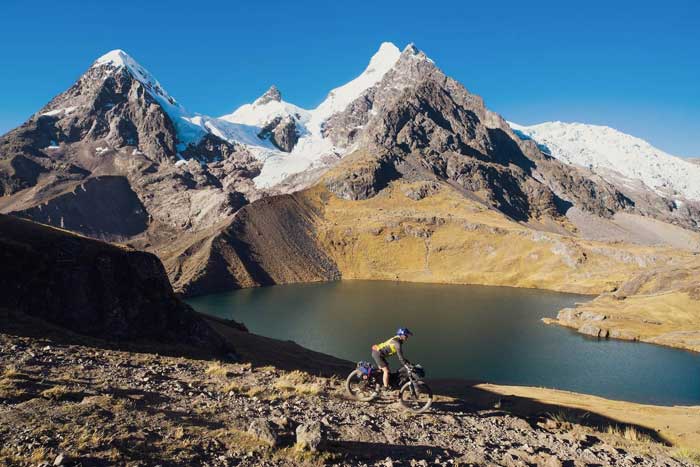
Somehow I managed to muster the concentration to navigate my bike down a steep and twisty singletrack descent. Spurred on by the beautiful landscape and thoughts of rest, we dispatched the rest of the descent down to the road, having very nearly closed a complete loop of the Ausangate massif. Our extension along the range towards Rainbow Mountain remained, but I was too sick to do anything, so we turned left instead of right, said goodbye to Brendan, and made our way a couple of miles back to Chillca, where I hoped 36 hours of rest might get me back in shape to finish the ride. Hana’s altitude problems lingered too, but the slightly lower camp provided a little bit of relief.
Although we were breathing better down at 14,000ft my gastric issues kicked in with a vengeance that night and every hour I was forced out in the freezing air. The following day was a write off and it wasn’t until the late afternoon that I managed to force down a boiled egg and half a packet of ramen.
At a junction in the road the next day we deliberated for several minutes. I still felt terrible and Hana, albeit not suffering from stomach problems, was still mildly ill with AMS. We decided to continue with the plan, reasoning that because it was uphill nearly all the way back to 16,400ft to reach Rainbow Mountain, we’d soon know if we were going to get worse, and at least it would be downhill if we decided to bail. We wanted the experience badly enough that we were still prepared to suffer for it, even after three days of illness.
Still short of breath and mildly nauseous we pressed on for a day and a half, riding up valley at first and then pushing the bikes up often unrideable singletrack and crossing one high pass. By midday the second day we were sidling around a mountainside on singletrack at about 16,000ft when the distinctive chevron-shaped layers of colourful mudstone that give Rainbow Mountain its name came into view. We’d made it. The view of Hana riding along a perfect trail with the Montaña de Siete Colores, as it’s known locally, looming high and proximate in the background will remain etched in my mind forever.
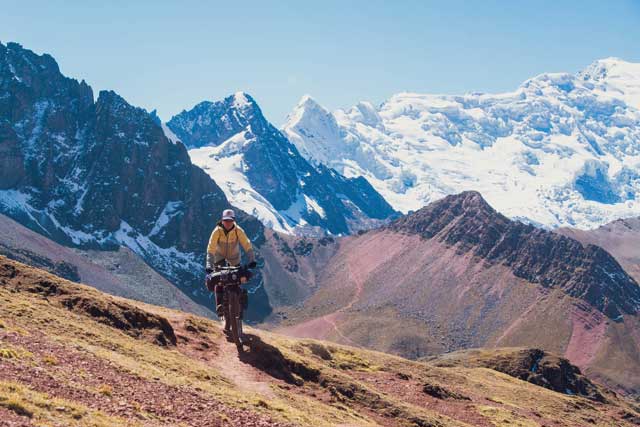
The rest of that day sped by in hallucinatory technicolour as we crossed yet another pass and dropped into the Valle Rojo (Red Valley), which is one of the most incredible landscape we’ve witnessed in three and a half years on the road. High, remote and stunningly beautiful, this alpine basin of sharp red ridges, shaly slopes, green tinged grasses and narrow singletrack makes an incredible ride. We stopped often to soak it up and take photos before finally stopping for the night to camp with big views over the valley.
We must have been finally hitting our stride, because the next morning’s pass seemed to go by with a much more manageable effort and we were feeling quite good as we crested its rocky notch. Below us lay over 5000 ft of descending on singletrack and dirt roads to reach the village of Pitumarca. We drank some water, adjusted our brakes and checked our tire pressures. The hard work was over and all that remained was the opportunity to relish the riding, our surroundings and the satisfaction that comes from self-propelled travel through a challenging environment.
Mark Watson and Hana Black rode 45,500km through 16 countries during their cycling odyssey from Alaska to Patagonia. You can read more about their journey at www.highlux.co.nz or follow them on Instagram @highluxphoto & @beinghana